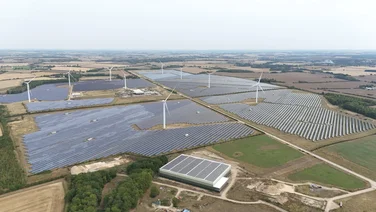- Solar hit a new half-hourly record of 13.2GW on 6 April
- Electricity output from UK solar installations saw bigger jumps in March
- Looking at May, solar increased 37 per cent year on year, which was the UK’s second-sunniest on record

The UK’s solar farms and rooftops generated a record 7.6 terawatt hours (TWh) of electricity during January to May, a 42% jump on the same period last year, a new analysis from Carbon Brief has found.
Smashing past the 5.4TWh from the same period last year, the solar generated between January and May 2025 means the UK’s solar capacity has also increased 160% in the past decade.
Solar hit a new half-hourly record of 13.2 gigawatts (GW) on 6 April and, for the first time, accounted for more than 10% of monthly electricity generation in two consecutive months (April and May).
Carbon Brief said that the solar electricity generated in 2025 to date has avoided the need to import gas costing around £600m, which would have released 6 million tonnes of carbon dioxide (MtCO2) when burned.
Despite this increase, the report found that solar was still only the UK’s sixth-largest source of electricity in 2025 to date, after gas (37TWh), wind (33TWh), imports (18TWh), nuclear (15TWh) and biomass (8.0TWh).
The report also said that this year’s solar was “partly driven” by the record sunniest spring, as well as rising capacity, which reached 20.2GW in 2024, up 2.3GW from 17.9KW in 2023. Solar capacity is due to reach at least 45GW by 2030, as part of the government’s ambition to become a clean energy superpower.

Thinking of installing solar panels?
Use the button below to hear from our trusted suppliers for a free, no obligation quote to install solar panels.
What were the key months for solar?
Electricity output from UK solar installations saw bigger jumps in March, according to the analysis and from the table below, where the 2,320 megawatts (MW) average was up 66% from 2024 and in April, up 53% to 3,189MW.
Looking at May, solar increased 37% year on year, which was the UK’s second-sunniest on record, with outreach hitting 3,383MW.
May also hit a new high of 2.5TWh, with the previous record set in June at 2.1TWh.
Please note, the table below from Carbon Brief, highlights the average monthly output of the UK’s solar capacity in MW. Output dips in the shorter days of the winter and general peaks with the shorter days in June.

The report also claimed that the electricity generated from solar between January and May is enough to offset the need for around 16TWh of imported gas.
“Buying this gas would have cost around £600m, based on recent wholesale prices, and burning it would have resulted in roughly 6MtCO2, adding nearly 2% to total UK emissions,” the report said.
The 16TWh of avoided gas is the equivalent to 10% of the UK’s net gas imports in the same period last year. In total, solar accounted for 11.6% of UK electricity generation in May 2025.
The UK weather changes
The UK experienced 653 hours of sunshine between 1 March to 31 May and was the sunniest on record since 1910. Before this year, the sunniest spring was in 2020.
UK sunshine has been on an increase since the 1980s, according to an analysis by the Met Office and Carbon Brief, and it also found that, on average, spring months have been around 15% sunnier over the past 10 years than the analysis’ reference period of 1961-1990.
In a recent statement by Emily Carlisle, scientist, Met Office, it said that seven of the top 10 sunniest springs on record for the UK since 1910 have occurred since the year 2000. Carlisle also said that 2025 was the fourth-sunniest season overall.
The extra sunshine this spring contributed to unusually high solar power output per unit of installed capacity, a metric known as the “capacity factor” of the UK’s solar plants.
Capacity has also continued to grow as energy prices have fallen, with early 2025 seeing the strongest start to the year since 2012.
The UK is also expected to add up to 3.5GW of new capacity by the end of the year as a whole, up from the 2.3GW in 2024.
This achievement is part of the government’s target of adding 45-47GW of solar by 2030 as part of its Plan for Change and to become a clean energy superpower.

Thinking of installing solar panels?
Use the button below to hear from our trusted suppliers for a free, no obligation quote to install solar panels.






